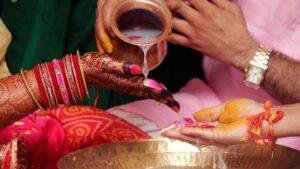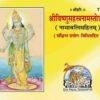Tesu flowers, also known as Flame of the Forest or Palash flowers, hold great significance in the celebration of Holi, which is a popular Hindu festival of colors.

About Tesu Flowers
- Botanical information: Tesu flowers are scientifically known as Butea monosperma and belong to the Fabaceae family. They are native to the Indian subcontinent and are typically found in tropical and subtropical regions.
- Appearance: Tesu flowers are bright orange-red in color and have a distinctive trumpet-like shape. They grow on trees that can reach up to 20 meters in height and have a smooth, grayish bark.
- Medicinal properties: Tesu flowers have several medicinal properties and are used in Ayurvedic medicine to treat various ailments such as fever, dysentery, and respiratory disorders. The flowers are also used to make a natural dye that is used in traditional textiles.
- Cultural significance: Tesu flowers have been an important part of Indian culture for centuries and are used in various festivals and ceremonies. In addition to Holi, they are also used in the worship of Goddess Durga during the festival of Navratri.
- Ecological significance: Tesu trees play an important role in maintaining the ecological balance of the region. They are nitrogen-fixing and help in soil conservation. The flowers are also a source of nectar for several species of butterflies and bees.
Tesu flowers are not only important for their cultural and religious significance but also have significant ecological and medicinal properties.
The story of Krishna and Tesu Flowers
According to Hindu scriptures, Lord Krishna was fond of playing pranks on his village’s women during the Holi festival. One of his favorite pranks was to throw colored water and powder on the women.
One day, Lord Krishna’s pranks went too far and he began throwing colored water on the women in a neighboring village. The women were furious and went to complain to his mother, Yashoda. Yashoda, who was a wise woman, came up with a plan to teach Lord Krishna a lesson.
She took some Tesu flowers and crushed them into a fine powder. She then mixed the powder with water to create a paste and applied it to Lord Krishna’s face. The paste was bright orange-red in color, and Lord Krishna was initially embarrassed to be seen in public with such an unusual appearance.
However, as he walked through the village, the other villagers began to admire his unique and colorful appearance. They asked him where he had gotten the beautiful color, and he proudly replied that it was a gift from his mother, Yashoda. From that day on, Tesu flowers became an important part of the Holi celebrations, and people began to use the flower’s bright orange-red color to make their own colored powders and paints.
Today, Tesu flowers are an integral part of the Holi celebrations, and their vibrant colors and unique appearance continue to be a symbol of the festival’s joy and excitement. The story of Lord Krishna and the Tesu flowers serves as a reminder of the importance of forgiveness and the power of a mother’s love in guiding her children towards the right path.
Their vibrant colors and unique shape make them a beautiful addition to any celebration, especially during the festive season of Holi. The importance of Tesu flowers on Holi can be attributed to the following reasons:
Aesthetic significance of Tesu Flowers on Holi

Tesu flowers are bright orange-red in color and their blooming coincides with the arrival of spring, which is the season of Holi. The vibrant and beautiful hues of these flowers add to the colorful and festive atmosphere of Holi.
Religious significance of Tesu Flowers in Holi
Tesu flowers are believed to be a favorite of Lord Krishna, who is a significant deity in Hindu mythology and is associated with Holi. According to legends, Lord Krishna used to play Holi with his friends using Tesu flowers and Gulal (colored powder).
Medicinal significance of Tesu Flowers in Holi
Tesu flowers have several medicinal properties and are used in Ayurvedic medicine to treat various ailments. It is believed that the fragrance of these flowers helps in relieving stress and anxiety, which can be beneficial during the festive season of Holi.
Traditional significance of Tesu Flowers in Holi
In some regions of India, it is a tradition to make a paste of Tesu flowers and apply it on the face and body during Holi. This paste is said to have a cooling effect on the skin and helps in preventing skin allergies and rashes caused by the colors used during Holi.
Overall, the Tesu flowers hold immense importance in the celebration of Holi and are an integral part of the festival’s cultural and religious significance.

The Divine Sansar Holi Celebration Gift Box contains a Jar of Dry Tesu Flowers
How to make Tesu Flower paste during Falgun or Holi
To make dry Tesu flower paste, you will need the following ingredients and materials:
Ingredients:
- Tesu flowers
- Water
Materials:
- Mortar and pestle or a food processor
- A fine mesh strainer or sieve
- A tray or a flat surface for drying the paste
Here’s a step-by-step guide to making dry Tesu flower paste:
- Collect a sufficient amount of Tesu flowers and remove any dirt or debris by rinsing them in water. It is best to collect the flowers early in the morning when they are fresh.
- Spread the flowers out on a tray or flat surface and let them dry in the sun for a few hours until they become crisp.
- Once the flowers are dry, remove the petals from the flowers and discard the rest of the plant material.
- Grind the Tesu flower petals into a fine powder using a mortar and pestle or a food processor.
- Add a small amount of water to the powder to make a paste. The amount of water you use will depend on the quantity of powder you have, but a general guideline is to use one part water to three parts powder.
- Mix the water and powder together until you have a smooth paste.
- Place the paste on a fine mesh strainer or sieve to remove any lumps or impurities.
- Spread the paste out on a tray or flat surface and let it dry in the sun for a day or until it is completely dry.

Your dry Tesu flower paste is now ready to use! To use it, simply add a small amount of water to the paste and mix it until you have a smooth consistency. You can then apply it to your face and body during Holi to add to the festive colors and to protect your skin from the harsh chemicals that are often found in commercial Holi colors.



















Add comment